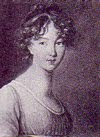
The
pattern for this Anklet comes from Weldon’s Practical Knitter, Number 49,
Twelfth Series (1890). It is also published in Weldon’s Practical Needlework,
Volume 5, Interweave Press, 2001.
These anklets are described as being “warm and comfortable for riding and
driving, and are also useful for walking on the moors in stormy weather” –
something I would love to do!
The original pattern calls for “dark brown Berlin wool” and “white Shetland wool,“ and knitting needles No. 12 and No. 8 (modern equivalents 2.50mm/US 2 and 4mm/US 6.) The anklet is knit “ in ribbed knitting” with “a lining of plain knitting” in two pieces, either flat or in the round, with the lining being sewn into the outside piece. There are also instructions for crocheted edges.
I
used vintage Beehive Moorland 3 ply Sock & Sweater Yarn (1950s-1960s?) in
number 580/Black Cofffee – All Wool, and Knit Picks Palette in White, on the
size of needles stated in the pattern. The inside piece, knit on the larger
needles, is looser than the brown, exterior piece, which is the one knit on the
smaller sized needles. They fit, however, exactly around each other.
I
cannot crochet so the upper edge on my anklet is a very reduced, rather
pathetic series of single strand loops made with 2mm crochet hook. I have added
the knitted Cyprus Edging to the lower cuff of the anklet, knit on 1.75mm/US
00. This pattern can be found in Weldon’s Practical Knitter, Number 55,
Fourteenth Series, 1890, and in the facsimile series, Weldon’s Practical
Needlework, Volume 5, Interweave Press, 2001.
The
anklet measures just about 3” wide, 5” long, (both flat), and 6” around,
unstretched. The flat brown piece measures 6” with a gauge/tension of 12
stitches to the inch; the white, 7” flat, with 7 stitches to the inch. The
Cyprus Edging stands 1” high.
I
do not own shoes from this era so I could not model the Anklet but I did try it
on and it stretches comfortably, not out of shape, and stays in place when I
walk, and is, of course, toasty warm for those walks on the moors in stormy
weather!











